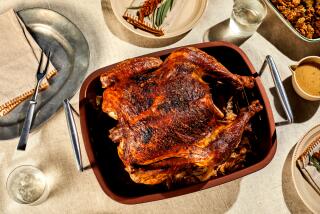Time Is Relative
- Share via
A turkey’s doneness should be judged by its internal temperature, rather than by the clock. Because new breeds of turkey cook more quickly than birds of years past and because the type of pan and method of cooking may affect cooking time, cooking charts are not the best way to judge a turkey’s doneness. Always use a cooking thermometer.
And what is the proper temperature for a roasted turkey? That’s actually a complicated question. The official recommendation of the U.S. Department of Agriculture is 180 degrees (that’s 5 degrees less than the recommendation a few years ago). But one expert at the USDA told us that harmful bacteria that may be present in raw poultry are effectively destroyed at 147 degrees. (The danger zone in which bacteria thrive and grow is 40 to 140 degrees.)
The reason for the higher recommendation? For one, home ovens and thermometers aren’t always calibrated accurately; the higher recommended temperature allows for a solid margin of error. It also leads to dried-out meat. Our compromise temperature in years past was 160 degrees. This year, for our own margin of error we’ve increased our recommendation to 165 degrees. This is the temperature the USDA recommends for all poultry. Why should our Thanksgiving turkeys be subjected to another 15 degrees and certain dryness while our chickens get to stay moist?
Note that there is usually a 10-degree increase in temperature that comes in the 15 to 20 minutes between removing the bird from the oven and carving it. That “push” after roasting should result in a final temperature of around 175 degrees. If you are cooking a stuffed turkey, the temperature of the stuffing at its center should be at least 165 degrees.
Insert the thermometer into the innermost part of the thigh, taking care not to touch the bone.
Other signs can indicate doneness. Press the fleshy part of the thigh with protected fingers; if the meat feels soft, or if the leg moves up and down easily and the hip joint gives readily or breaks, the turkey should be done. Doneness can also be determined by inserting a long-tined fork into the thickest area of the inner thigh. If the juices run clear, not pink, the turkey should be done.
We’ve included the USDA’s time estimates for determining how long it should take a turkey to get to 180 degrees. Use it even if you’re cooking your turkey to 165 to help you budget your time.
Unstuffed Weight Roasting Time
8 to 12 pounds--2 3/4 to 3 hours
12 to 14 pounds--3 to 3 3/4 hours
14 to 18 pounds--3 3/4 to 4 1/4 hours
18 to 20 pounds--4 1/4 to 4 1/2 hours
20 to 24 pounds--4 1/2 to 5 hours
Stuffed Weight Roasting Time
8 to 12 pounds--3 to 3 1/2 hours
12 to 14 pounds--3 1/2 to 4 hours
14 to 18 pounds--4 to 4 1/4 hours
18 to 20 pounds--4 1/4 to 4 3/4 hours
20 to 24 pounds--4 3/4 to 5 1/4 hours
More information about cooking times is available toll-free from the USDA’s Meat and Poultry Hotline at (800) 535-4555.
More to Read
Eat your way across L.A.
Get our weekly Tasting Notes newsletter for reviews, news and more.
You may occasionally receive promotional content from the Los Angeles Times.








